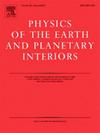关于金星地壳中对流的可能性
IF 2.4
3区 地球科学
Q2 GEOCHEMISTRY & GEOPHYSICS
引用次数: 0
摘要
我们通过利用最近开发的从下面或从内部加热的温度和应力依赖粘度流体中对流开始的标度定律来评估金星地壳中对流的可能性。我们发现地壳对流可以在表面热通量、地壳厚度和流变学的合理范围内发生。如果晶粒尺寸小于0.1 mm,地壳较厚,接近辉长岩-榴辉岩过渡,则在亚固体温度下可发生地壳对流。对于较大的晶粒尺寸,特别是通过位错蠕变发生变形的地方,地壳对流可能只在超固相温度下发生。如果金星地壳中确实存在地壳对流,将会提高地壳的热传导效率,影响行星内部的动力学和演化。它还会在地壳内部产生热变化,从而影响重力和地形数据分析对弹性厚度和热通量的约束。进一步研究部分熔融地壳的两相动力学对于更好地理解地壳对流和准确解释地表观测结果至关重要。本文章由计算机程序翻译,如有差异,请以英文原文为准。

On the possibility of convection in the Venusian crust
We evaluate the possibility of convection in the Venusian crust by utilizing recently developed scaling laws for the onset of convection in temperature- and stress-dependent viscosity fluids, heated from below or from within. We find that crustal convection can occur within plausible ranges of surface heat flux, crustal thickness, and rheologies. Crustal convection can occur at subsolidus temperatures if the grain size is less than 0.1 mm and the crust is relatively thick, close to the gabbro-eclogite transition. For larger grain sizes, particularly where deformation occurs through dislocation creep, crustal convection is likely to occur only at supersolidus temperatures. If crustal convection does occur in the Venusian crust, it would increase heat transport efficiency in the crust and affect the interior dynamics and evolution of the planet. It would also generate thermal variations within the crust that would affect the constraints on the elastic thickness and the heat flux from gravity and topography data analysis. Further investigation of the two-phase dynamics of a partially molten crust is essential for a better understanding of crustal convection and accurate interpretation of surface observations.
求助全文
通过发布文献求助,成功后即可免费获取论文全文。
去求助
来源期刊

Physics of the Earth and Planetary Interiors
地学天文-地球化学与地球物理
CiteScore
5.00
自引率
4.30%
发文量
78
审稿时长
18.5 weeks
期刊介绍:
Launched in 1968 to fill the need for an international journal in the field of planetary physics, geodesy and geophysics, Physics of the Earth and Planetary Interiors has now grown to become important reading matter for all geophysicists. It is the only journal to be entirely devoted to the physical and chemical processes of planetary interiors.
Original research papers, review articles, short communications and book reviews are all published on a regular basis; and from time to time special issues of the journal are devoted to the publication of the proceedings of symposia and congresses which the editors feel will be of particular interest to the reader.
 求助内容:
求助内容: 应助结果提醒方式:
应助结果提醒方式:


